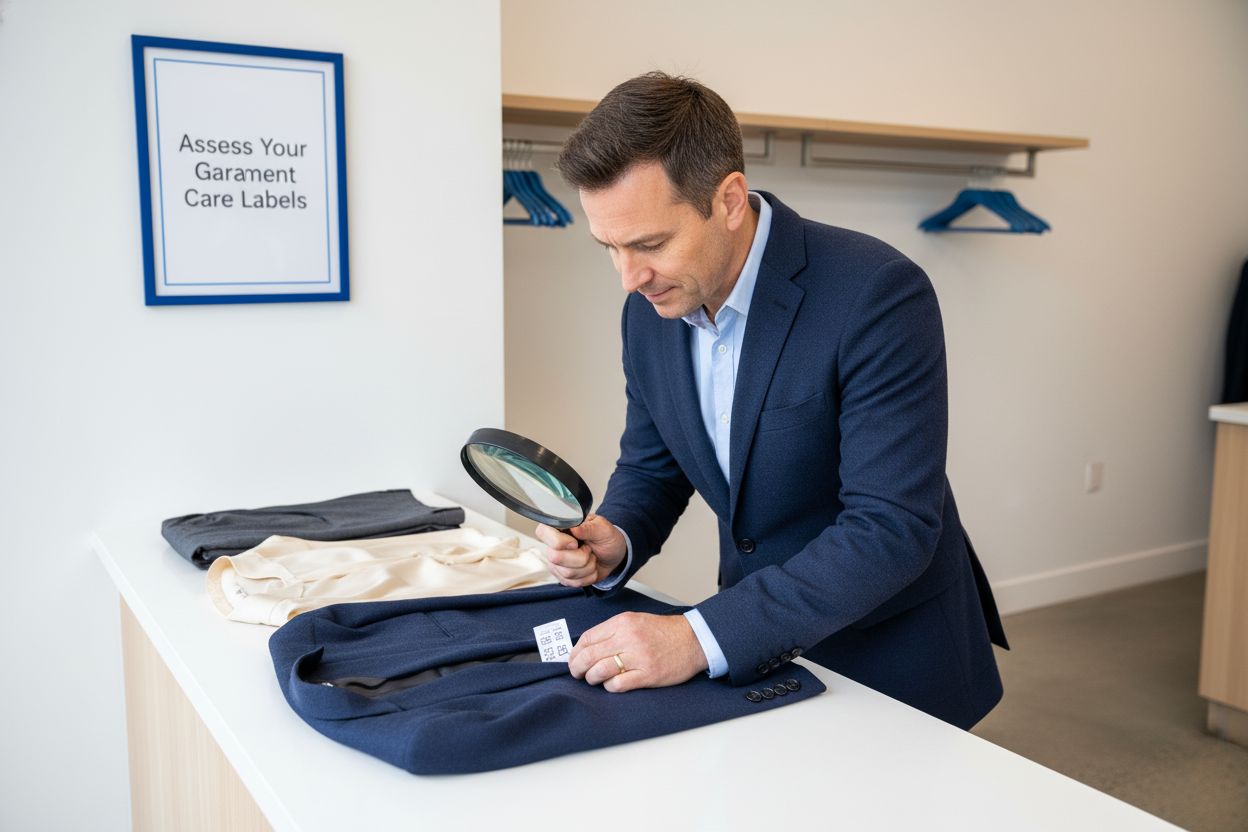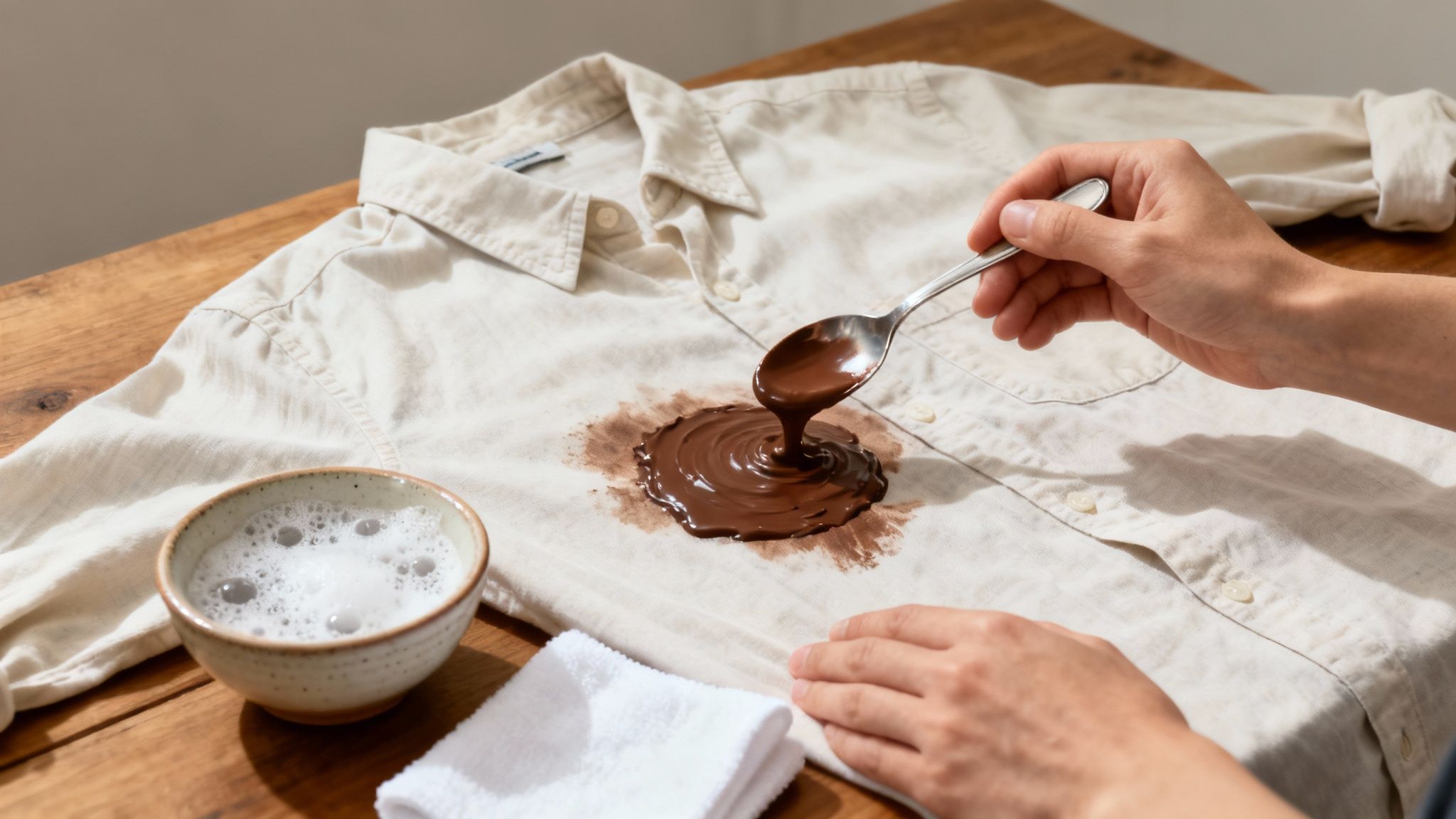Fabric Softener Eco Friendly: Your Guide to Greener Laundry
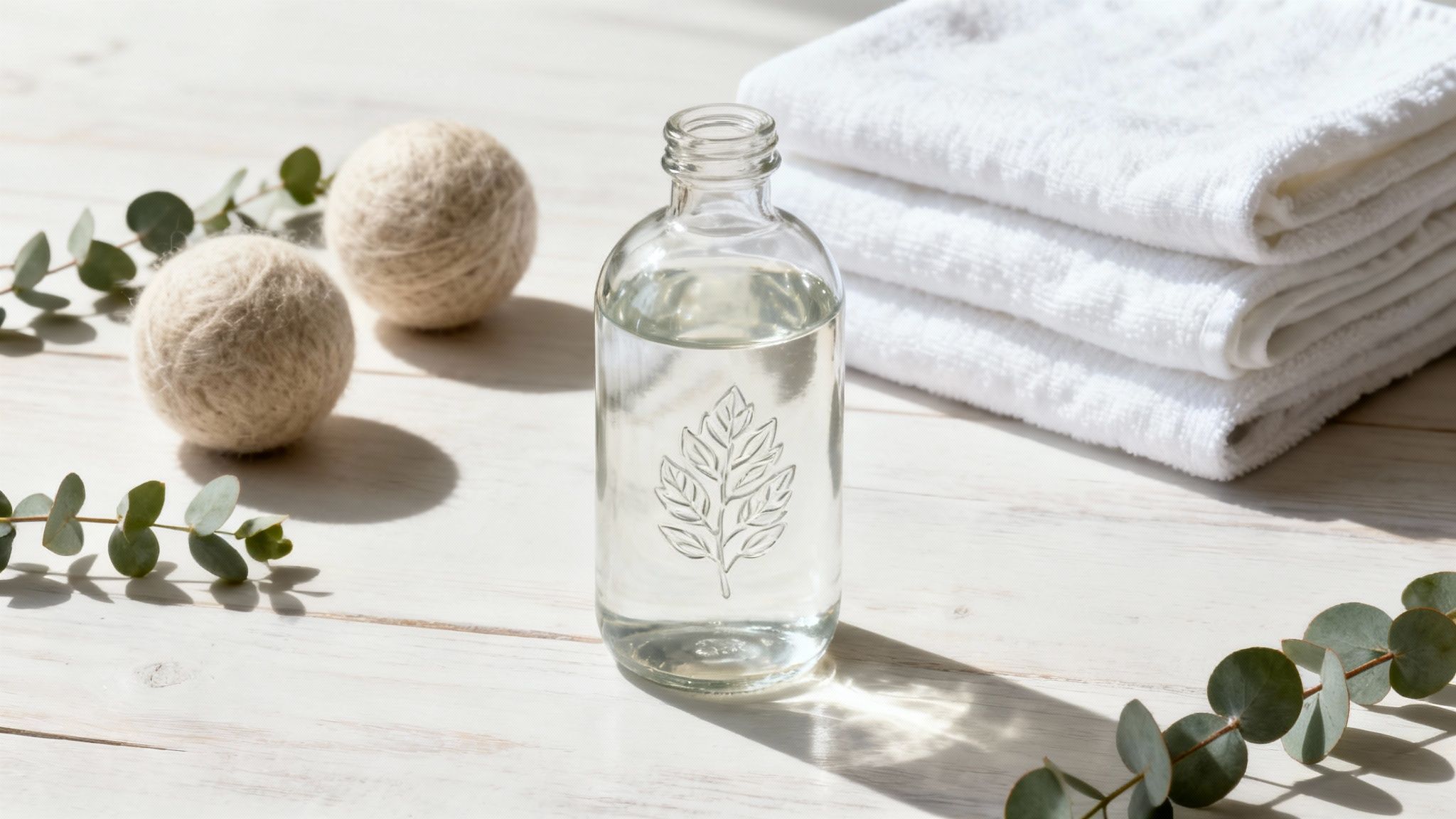
That fresh-out-of-the-dryer scent feels amazing, but it often comes with a hidden cost to both your health and the environment. A truly eco-friendly fabric softener ditches the artificial fragrances and harsh chemicals. Instead, it relies on things like plant-based ingredients, biodegradable formulas, and sustainable packaging to get your clothes soft, safely and effectively.
Why Make the Switch to Eco Friendly Fabric Softener?
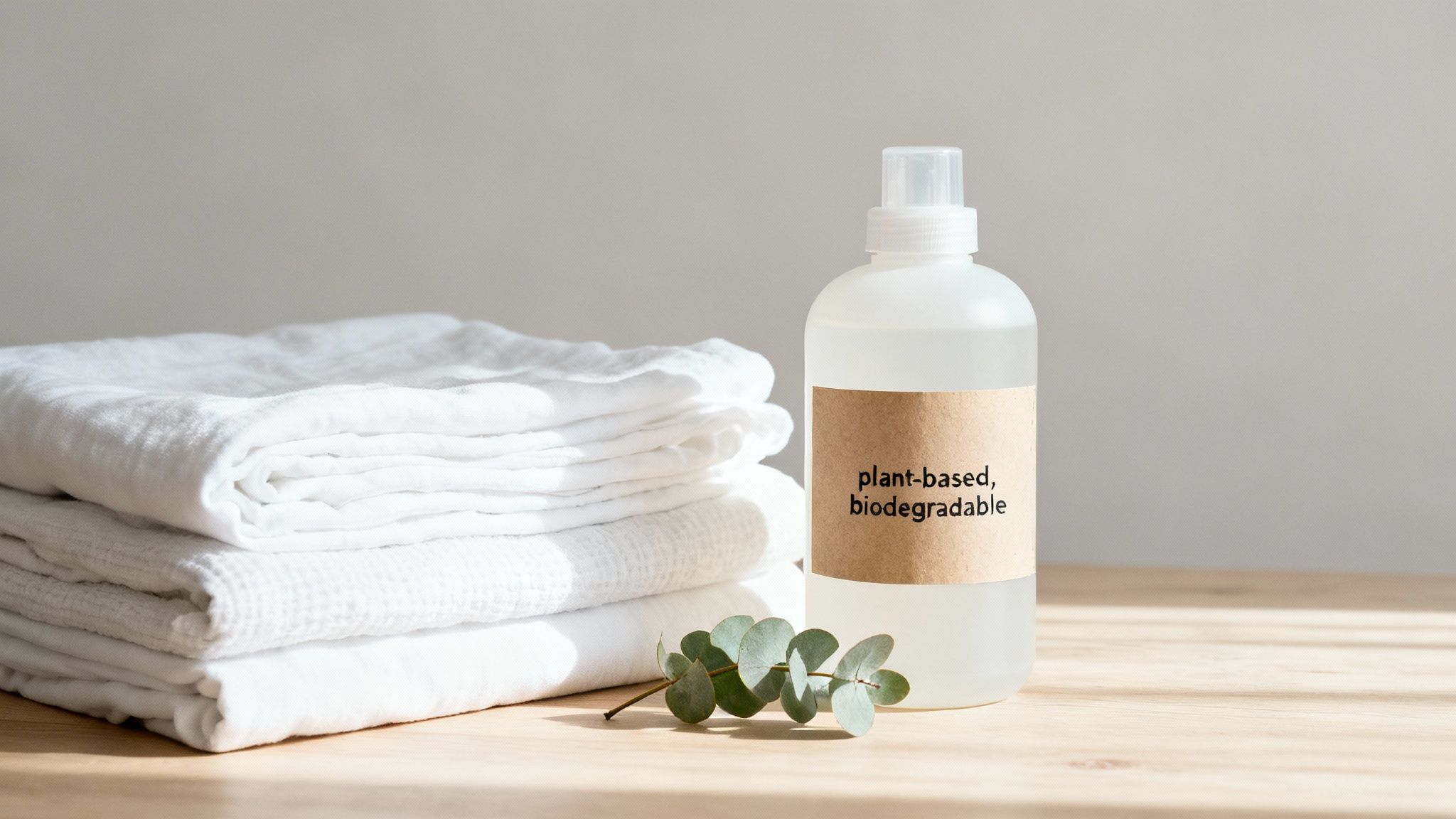
Ever stop to think about what's actually in that bright blue liquid? Many of the big-name fabric softeners use chemicals that can leave a waxy film on your clothes, irritate sensitive skin, and cause real problems for aquatic life once they go down the drain. This is where eco-friendly options completely change the game.
Think of it less like a laundry add-on and more like an upgrade for your whole routine. When you choose greener alternatives, you're not just getting fluffy towels. You're actively protecting your family from potential allergens and shrinking your household's environmental footprint.
The Growing Demand for Greener Laundry
This isn't just a small trend anymore; it's a full-blown movement. The global market for fabric softener is expected to jump from USD 24.8 billion in 2025 to a whopping USD 43.8 billion by 2035. What's driving that? A huge surge in awareness about everything from skin sensitivities to environmental impact. As more of us look for safer, more sustainable products for our homes, the demand for genuinely eco-friendly options just keeps growing.
Making this small switch is a simple way to align your daily habits with a healthier lifestyle. It's a fantastic first step that fits right in with the principles of sustainable living and how they can be woven into all parts of your life.
Key Benefits of Going Green
Making a more conscious choice in the laundry aisle brings some real, tangible benefits that go way beyond just softer clothes. (If you want a refresher on the basics, our guide on what fabric softener is used for explains how these greener alternatives improve on the original idea.)
Here’s a quick look at why so many people are making the change.
- Gentler on Skin: Plant-based formulas skip the harsh chemicals known for triggering skin irritation and allergic reactions. This makes them a perfect choice for families, especially those with little ones or sensitive skin.
- Better for Your Clothes: Eco-friendly softeners rinse away cleanly. They don't leave behind that gunky residue that can build up over time and make your towels less absorbent or your activewear less breathable.
- Protects Waterways: The ingredients are biodegradable, meaning they break down naturally and harmlessly. This prevents toxic chemicals from polluting our rivers, lakes, and oceans.
Decoding the Ingredient Label: What to Avoid
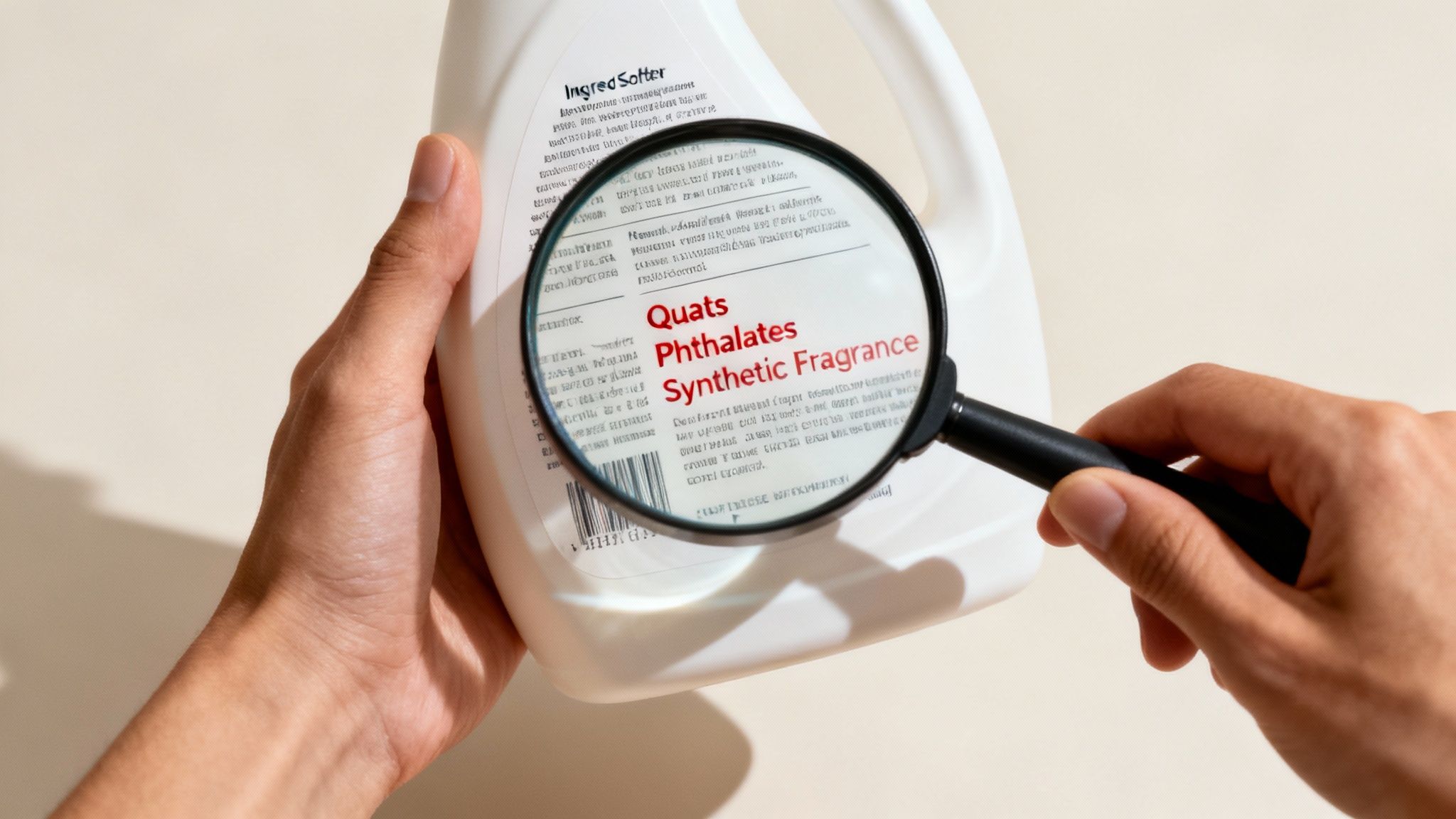
Walking down the laundry aisle can feel like you need a chemistry degree, right? Especially when you're trying to pick a truly eco-friendly fabric softener. So many conventional products are packed with ingredients that have long, complicated names—and for good reason. Understanding what to leave on the shelf is your first, best step toward a greener, healthier laundry routine.
The main offenders in most traditional fabric softeners are Quaternary Ammonium Compounds, which you’ll often see listed as “Quats.” You can think of these as a waxy coating for your clothes. Sure, they make fabrics feel soft right out of the dryer, but they also create a buildup that makes your towels less absorbent and stops your workout gear from wicking away moisture.
This residue doesn't just mess with your clothes. It can also accumulate inside your washing machine, creating a nasty film that can lead to mechanical problems down the road. It's a classic case of a short-term fix with long-term consequences for your fabrics and your appliances.
Hidden Health and Environmental Hazards
Beyond Quats, two other major red flags are synthetic fragrances and phthalates. That powerful "fresh linen" scent? It often comes from a cocktail of undisclosed chemicals that manufacturers can legally hide under the vague term "fragrance."
These mystery chemicals can be huge irritants for anyone with sensitive skin, allergies, or asthma. They release volatile organic compounds (VOCs) into your home’s air and, once they wash down the drain, they pose a serious threat to aquatic life.
Phthalates, often used to make those synthetic fragrances last longer, are another huge concern. They are known endocrine disruptors, which means they have the potential to interfere with the body's natural hormonal systems. Simply choosing products without these additives is a powerful way to protect your family's health.
The easiest way to make a smart choice is to look for products that are transparent about their ingredients. A genuinely eco-friendly fabric softener will proudly list what’s inside, and you'll immediately notice the absence of all these problematic chemicals.
The Heroes of Green Laundry
So, if you're avoiding all that stuff, what should you look for? The great news is that effective, natural alternatives are everywhere and they're refreshingly simple. These ingredients work with your fabrics, not against them, leaving them soft and clean without any of the harmful gunk.
Here are the key players in the world of eco-friendly fabric softening:
- Plant-Derived Softeners: Look for ingredients like coconut oil or rapeseed oil derivatives. They provide natural softening without the waxy buildup of Quats and are biodegradable and gentle on skin.
- Essential Oils: For a natural scent, seek out products scented with pure essential oils like lavender, citrus, or eucalyptus. You get a light, pleasant aroma without the synthetic chemicals and their associated health risks.
- Simple Acids: Believe it or not, distilled white vinegar is an incredibly effective and cheap fabric softener. It works by breaking down leftover detergent residue, leaving clothes naturally soft. And no, your laundry won't smell like a salad!
Once you get familiar with these simple swaps, you can confidently read any label and tell the difference between a truly green product and one that's just "greenwashing." This knowledge puts you in the driver's seat, empowering you to make the best choice for your laundry, your home, and the planet.
Exploring the Best Natural Fabric Softener Alternatives
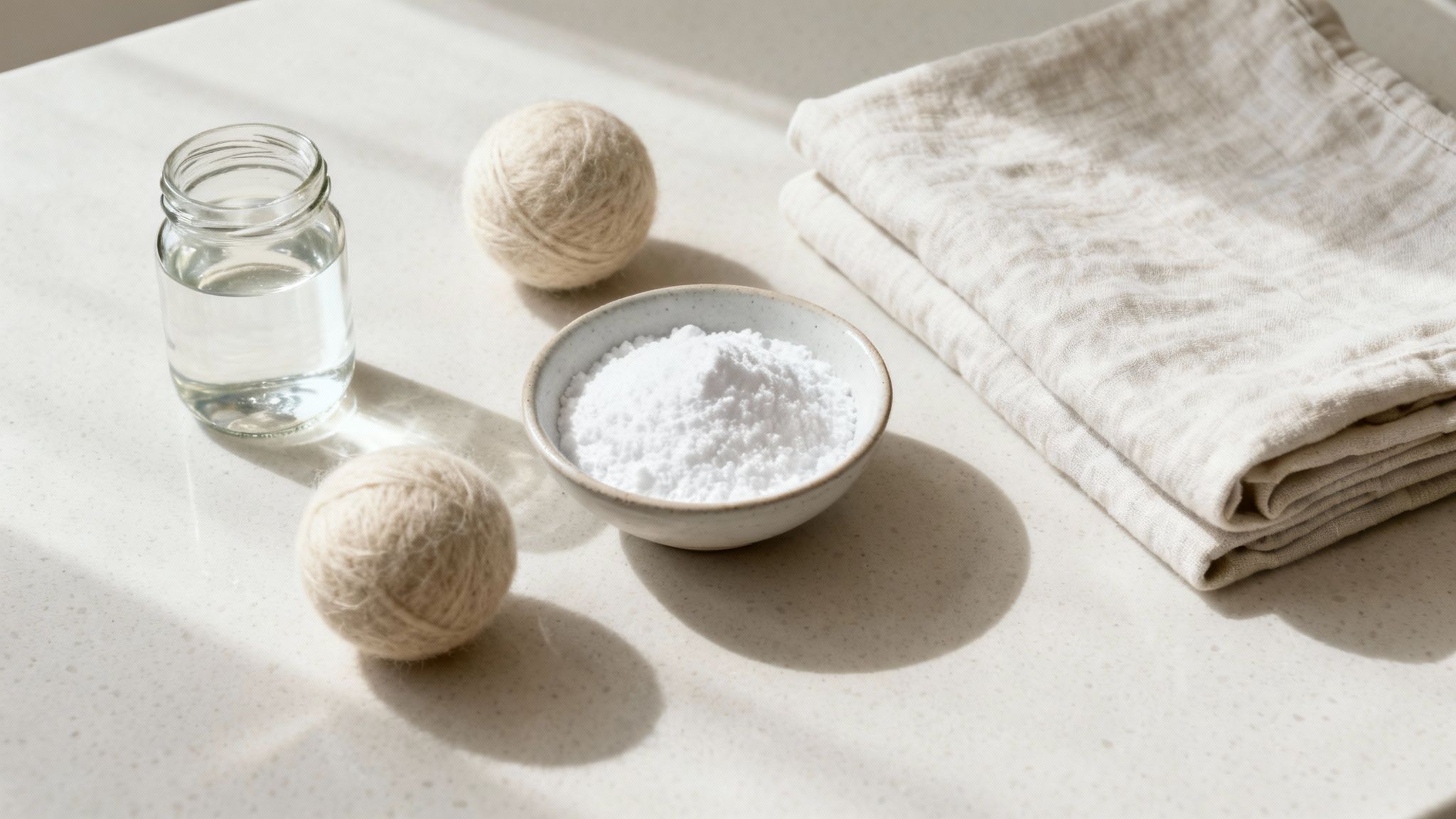
Alright, now that you know what to look out for on the ingredient label, we can get to the fun part—finding a fantastic green alternative for your laundry room. Putting knowledge into practice feels great, and the best news is you have plenty of effective, natural options that can fit any lifestyle and budget.
Whether you're looking for a convenient store-bought product or a simple DIY recipe, a better fabric softener is out there waiting for you.
Loads of companies are now offering plant-based liquid softeners and biodegradable dryer sheets. This shift isn't a fluke; it's a direct response to people like you demanding greener choices. In fact, the market for fabric softener sheets alone is expected to jump from USD 21.37 billion in 2024 to a whopping USD 32.84 billion by 2034. This growth is almost entirely fueled by innovation in sustainable, low-waste materials. You can dig into the numbers in this fabric softener sheet market report.
Simple and Effective DIY Solutions
You don’t have to go far to find a powerful fabric softener. A quick look in your kitchen pantry will reveal some of the best-kept secrets in laundry care. These household staples are cheap, non-toxic, and work surprisingly well at leaving clothes soft and fresh without any chemical gunk left behind.
- Distilled White Vinegar: This is the undisputed champion of the DIY world. The acetic acid in vinegar is a natural pro at breaking down the alkaline residue left by detergents, which is what makes fabrics feel stiff. Just pour a half-cup into your machine's softener dispenser during the rinse cycle.
- Baking Soda: Another pantry hero, baking soda helps soften the water by balancing its pH level. This prevents hard water minerals from clinging to your clothes and making them scratchy. It also works as a fantastic natural deodorizer. Simply add a half-cup directly into the wash drum with your detergent at the start.
These two ingredients are powerhouses on their own, but they can be a real one-two punch for tackling stubborn laundry problems. If you're curious about the science behind it, we break it all down in our guide to washing clothes with baking soda and vinegar.
Quick Tip: Worried your clothes will smell like a salad? Don't be. The vinegar scent completely washes out during the final rinse, leaving your laundry smelling perfectly neutral and clean.
Reusable Game-Changers: Wool Dryer Balls
If you're aiming to kick single-use products to the curb, wool dryer balls are a brilliant investment. Think of them not just as a replacement for dryer sheets, but as a serious upgrade. Made from tightly felted wool, they're a completely natural and reusable tool that brings a ton of benefits to your laundry routine.
Here’s how they work: as they tumble around in the dryer, they create space between your clothes. This simple action helps hot air circulate way more efficiently, which can slash your drying time by up to 25%. Less time in the dryer means a lower energy bill and less wear and tear on your favorite outfits.
The constant tumbling also physically softens clothes by fluffing up the fibers, cutting down on stiffness and static without a single chemical. Plus, they can last for over 1,000 loads, making them an incredibly budget-friendly and zero-waste choice. For a hint of scent, just add a couple of drops of your favorite essential oil to each ball before tossing them in.
Comparing Eco-Friendly Softener Options
With so many great alternatives, which one is right for you? It really depends on what you value most—convenience, cost, or a specific laundry goal. This table breaks down the pros and cons of the most popular options to help you decide.
Ultimately, the best choice is the one you'll stick with. Whether you fall in love with the simplicity of vinegar or the energy-saving power of wool dryer balls, you're making a fantastic choice for your home and the planet.
Mastering Your Green Laundry Routine
Choosing a great eco-friendly fabric softener is a fantastic first step. But to really get the most out of it—and make your green laundry routine stick—it all comes down to how you use it. You’ll quickly find that less is often more. Nailing a few simple principles will save you money, protect your clothes, and give you that perfect softness every time.
One of the most common mistakes people make is pouring in too much product. It feels intuitive, right? More softener equals softer clothes. But it’s actually the opposite. Overdoing it, even with a natural softener, creates a gradual buildup on fabric fibers. Over time, this can leave clothes feeling stiff or even a little greasy, and it kills their ability to absorb moisture. Always stick to the recommended amount on the label—your wallet and your wardrobe will thank you for it.
Know When to Skip the Softener
Just as important as knowing how much to use is knowing when not to use it at all. Some fabrics are engineered for specific jobs, and fabric softeners can get in the way of them doing what they do best. Giving these items a pass will keep them in top shape for much longer.
- Athletic Wear: Most activewear is designed to pull sweat away from your skin. Softeners can clog the tiny pores in these technical fabrics, which ends up trapping odors and ruining their moisture-wicking magic.
- Microfiber Towels: These cloths are superstars at absorbing because of their unique fiber structure. A coat of softener makes them far less effective at soaking up spills or cleaning surfaces.
- Terrycloth Towels: While we all love a fluffy towel, using softener on them too often can reduce how much water they can actually absorb. A much better trick is to run them with a vinegar rinse every few washes to strip away residue and bring back that natural softness.
A green laundry routine is just the beginning. If you're looking to clean up your whole home, exploring the best eco-friendly cleaning products can help create a healthier space from top to bottom.
Making It Effortless with a Laundry Service
A packed schedule shouldn't get in the way of your sustainable goals. If you use a pickup and delivery service like Columbia Pike Laundry, it’s super easy to stick to your preferences. When you schedule your service, just add a quick note to let us know which softener you prefer—or if you'd rather we skip it altogether.
That simple step ensures your laundry gets the exact care you want, meeting your standards without you having to lift a finger. It’s the perfect example of how convenience and conscious living can go hand-in-hand. For more ideas on greening your entire wash day, check out our guide on how to make your laundry routine more sustainable.
Understanding Green Certifications and Labels
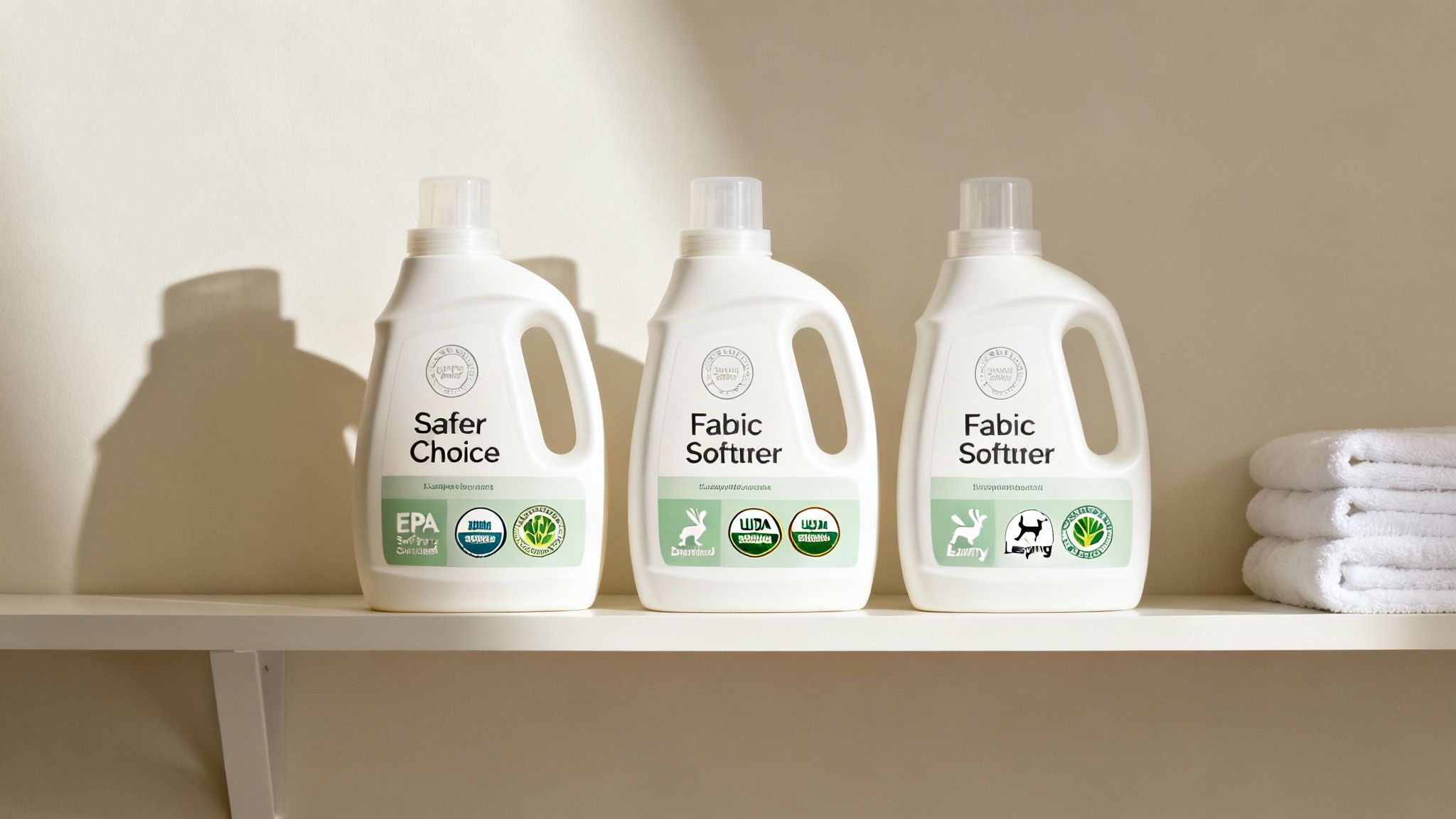
Walking down the cleaning aisle can feel a bit overwhelming. With so many bottles shouting "green" and "natural" at you, how do you know what’s legit and what’s just clever marketing? It’s easy to feel lost.
This is where third-party certifications come into play. Think of them as a trustworthy shortcut—a seal of approval from an unbiased expert who’s already done the tough homework for you. These labels aren't just for show; they signify that a product has been through rigorous testing to prove it meets high standards for safety, sustainability, and ethical production. Learning to spot these logos is the quickest way to cut through the noise.
Key Labels to Look For
Once you know the main players, decoding the symbols on the packaging gets a whole lot simpler. Each certification focuses on a different piece of the puzzle, from the safety of the ingredients to how the product was made.
- EPA Safer Choice: This label is a big one. It means the U.S. Environmental Protection Agency has vetted every single ingredient for potential impacts on human health and the environment. It’s a powerful signal that the formula is a safer bet for your family, your pets, and the planet.
- USDA Certified Biobased Product: This certification tells you the product is made from renewable stuff, like plants and other agricultural materials. The label even gives you the exact percentage of biobased content, so you know exactly what you’re getting. No guesswork involved.
- Leaping Bunny Certified: If animal welfare is a top priority, this is the gold standard you want to see. The Leaping Bunny logo is a promise that no animal testing was used at any point in the product’s development, from the raw ingredients all the way to the finished formula.
Spotting these certifications is your best defense against "greenwashing," where companies make misleading claims about their environmental benefits. A verified label means a company has done the work to prove its commitment.
This demand for transparency isn't just a local trend; it's a global movement. Take the Asia Pacific region, for example. It's on track to command over 40% of the global fabric softener market by 2025, largely driven by consumers demanding products with real eco-credentials. You can dig deeper into these market trends and their drivers. By learning what these labels mean, you're not just buying a product—you're supporting brands that are genuinely invested in a healthier planet.
Got Questions About Eco-Friendly Fabric Softeners? We've Got Answers.
Switching up your laundry routine to be a bit kinder to the planet is a brilliant move. But let's be honest, it can feel like you're learning a whole new language, and it’s completely normal to have a few questions.
To help you feel totally confident in your choices, we’ve put together answers to the most common questions we hear about eco-friendly fabric softener. Consider this your myth-busting guide to mastering your sustainable laundry game.
Are Wool Dryer Balls A Good Replacement For Fabric Softener?
They’re not just good—they’re one of the best alternatives out there. Wool dryer balls work in a really simple, physical way. As they tumble around in your dryer, they get in between your clothes, creating pockets of air.
This simple separation helps hot air circulate way more efficiently, which can cut your drying time by up to 25%. Less time in the dryer means a lower energy bill for you.
Plus, all that tumbling naturally softens fabrics and fights static cling without a single chemical. They last for hundreds (sometimes thousands!) of loads, making them a zero-waste, super cost-effective choice. They don't have a scent on their own, but if you miss that, just add a few drops of your favorite essential oil to each ball for a light, natural fragrance.
Expert Insight: An appliance repair person once told me the waxy residue from conventional dryer sheets is a major culprit for clogged lint traps. Over time, that buildup can cause real mechanical and electrical problems. Wool dryer balls are completely natural and won't harm your machine, making them a much safer bet for the long haul.
Will Using White Vinegar Make My Clothes Smell Bad?
This is probably the biggest myth holding people back, but the answer is a definite no! While distilled white vinegar has a strong, pungent smell right out of the bottle, that scent completely rinses away in the final wash cycle.
I promise, your clothes will come out smelling fresh and neutral—not like a salad dressing. The magic is in the acetic acid, which is brilliant at breaking down the stubborn alkaline residues from detergents that make fabrics feel stiff. Just pour about a half-cup into your machine's fabric softener dispenser. As a bonus, it’s also a fantastic odor-remover and helps keep the inside of your washing machine sparkling clean.
If A Fabric Softener Is "Unscented," Does That Mean It's Eco-Friendly?
Not always. Choosing an unscented product is a great first step, as it helps you dodge synthetic fragrances and the phthalates that make them linger. But the core formula might still be full of stuff you want to avoid.
Many unscented softeners still rely on chemicals like Quaternary Ammonium Compounds (or "Quats") to do the softening, and these ingredients aren't known for being biodegradable.
A truly eco-friendly fabric softener is green through its entire lifecycle. That means it's made with plant-based, biodegradable ingredients and comes in sustainable, low-waste packaging. Don't just stop at "fragrance-free." Take a second to scan the label for plant-derived ingredients and look for certifications you can trust, like EPA Safer Choice, to be sure the product is genuinely green.
How Can I Be Sure A Product Is Truly Cruelty-Free?
The most reliable way is to look for a logo from a third-party organization that's done the vetting for you. In the world of cruelty-free products, the Leaping Bunny logo is the gold standard.
This internationally recognized symbol is your guarantee that no animal testing happened at any point in the product's creation—from the raw ingredients all the way to the final bottle on the shelf. While some brands might create their own bunny logos or just print "not tested on animals" on the package, the Leaping Bunny certification is independent, verifiable proof. It lets you shop with total confidence, knowing your purchase is an ethical one.
Ready to reclaim your time and enjoy a truly effortless, eco-friendly laundry day? Columbia Pike Laundry handles everything with care, from sorting and washing to using your preferred green products. Schedule your first pickup and discover the relief of laundry, done right.
Popular Blog Articles

Meet the Author
Daniel Logan didn’t start CPL because he loved laundry. He started it because his family was drowning in time debt, and laundry was one of the biggest weights.
Mornings were chaos with two kids under 5. Evenings felt like catch-up. And weekends? Gone to sorting socks and folding piles.
He knew his story wasn’t unique. So he built a business that gave families like his just a little bit of breathing room one load at a time.
With no laundry experience but deep tech skills, Daniel rolled up his sleeves, doing every job himself while building systems that turned it into a modern laundry service that saves customers time, simplifies their lives, and delivers reliability they can count on.
That’s where CPL began. Not from a playbook, but from pain. From one dad trying to buy back time: for himself, and for every household like his.


